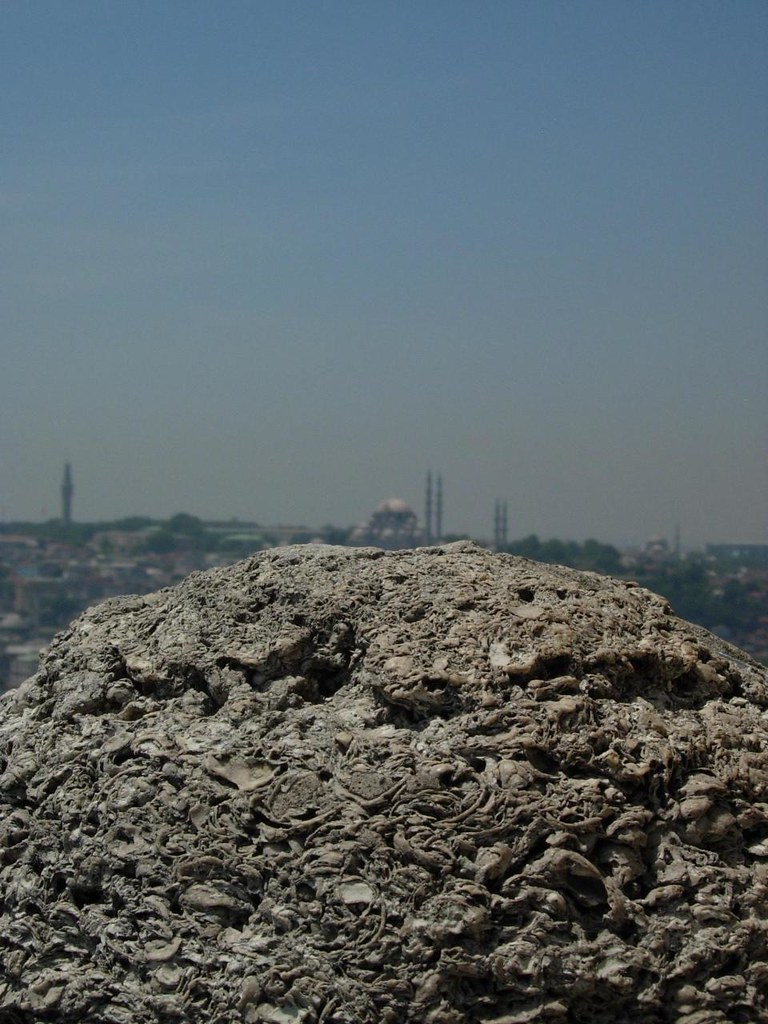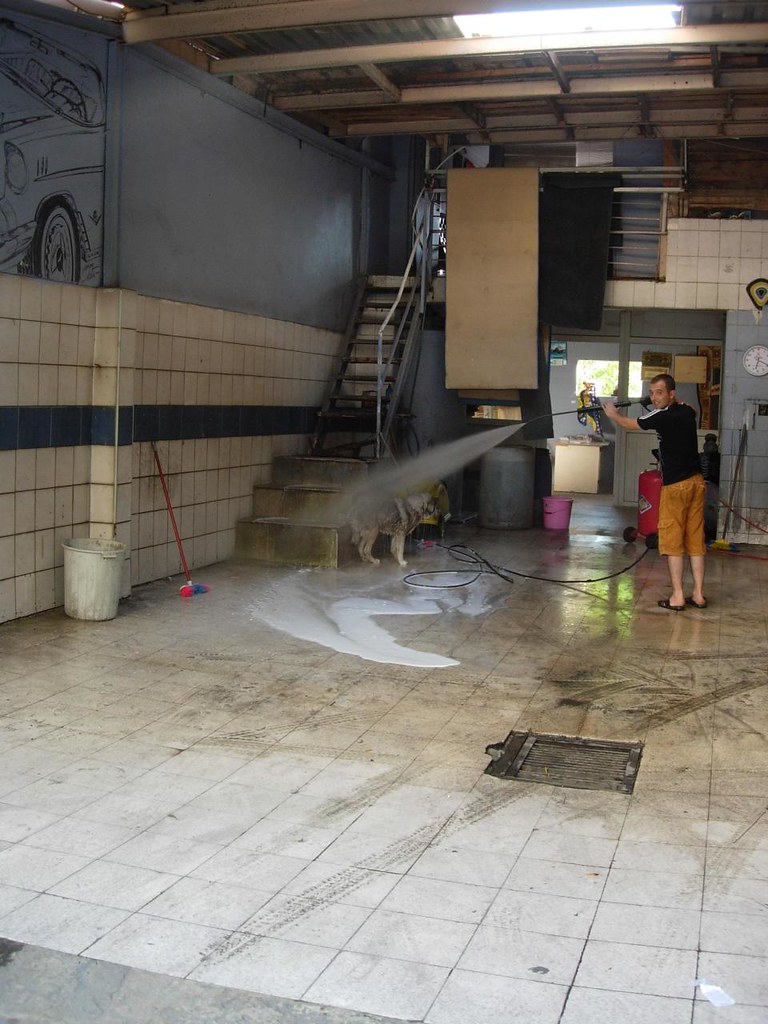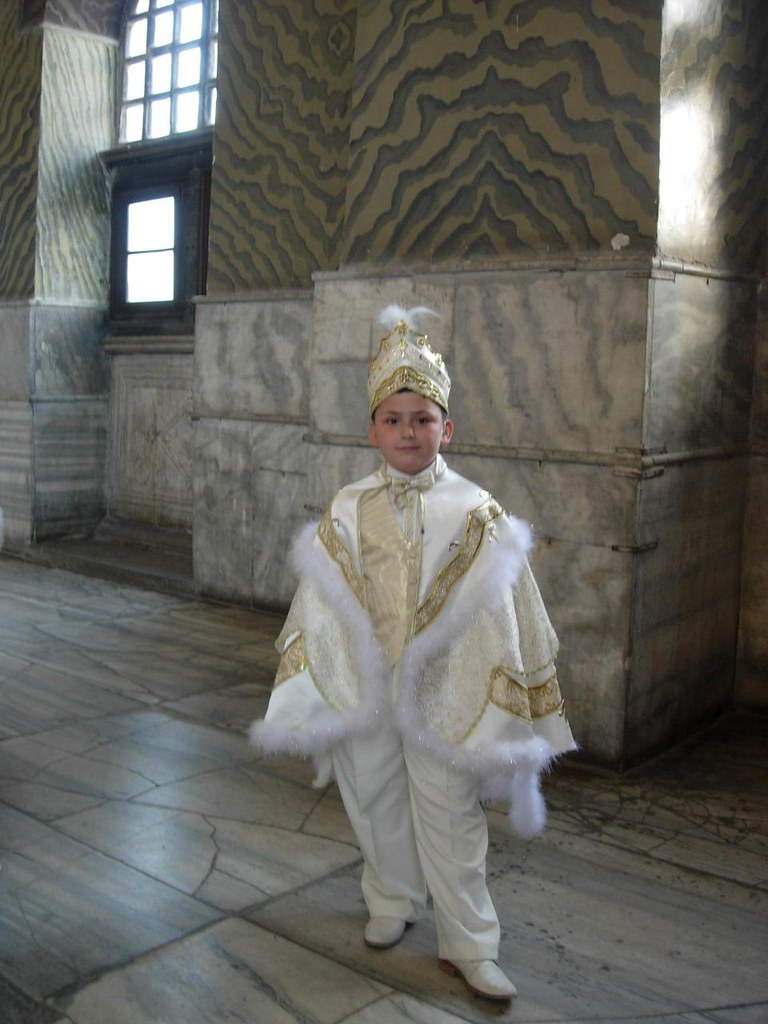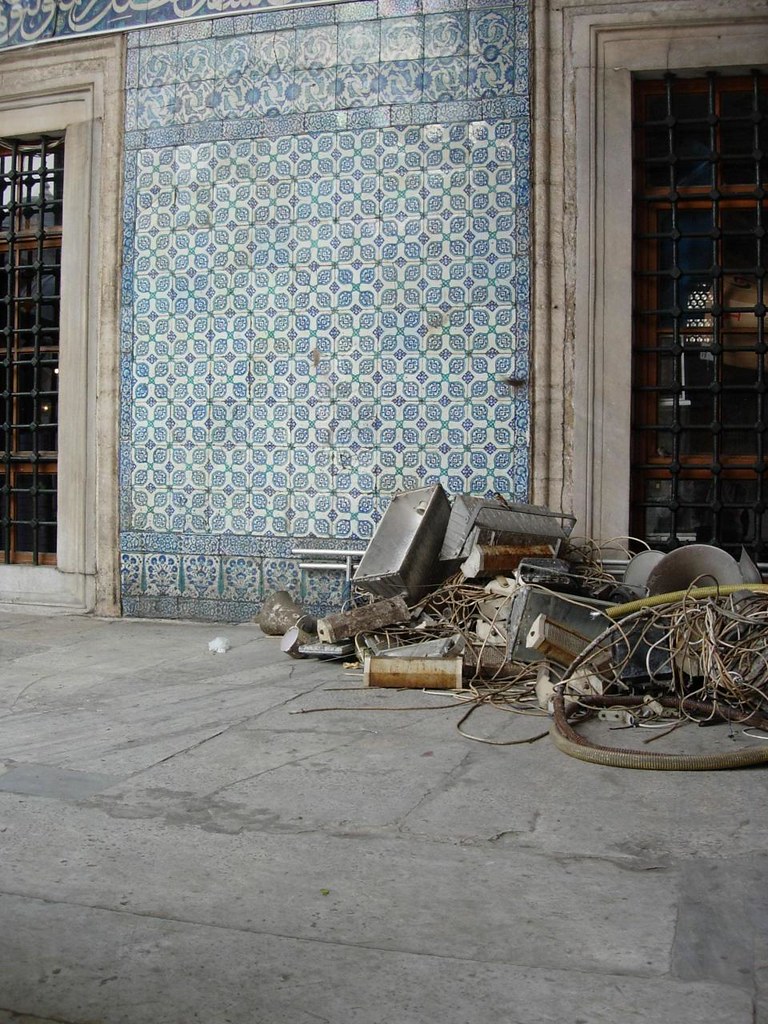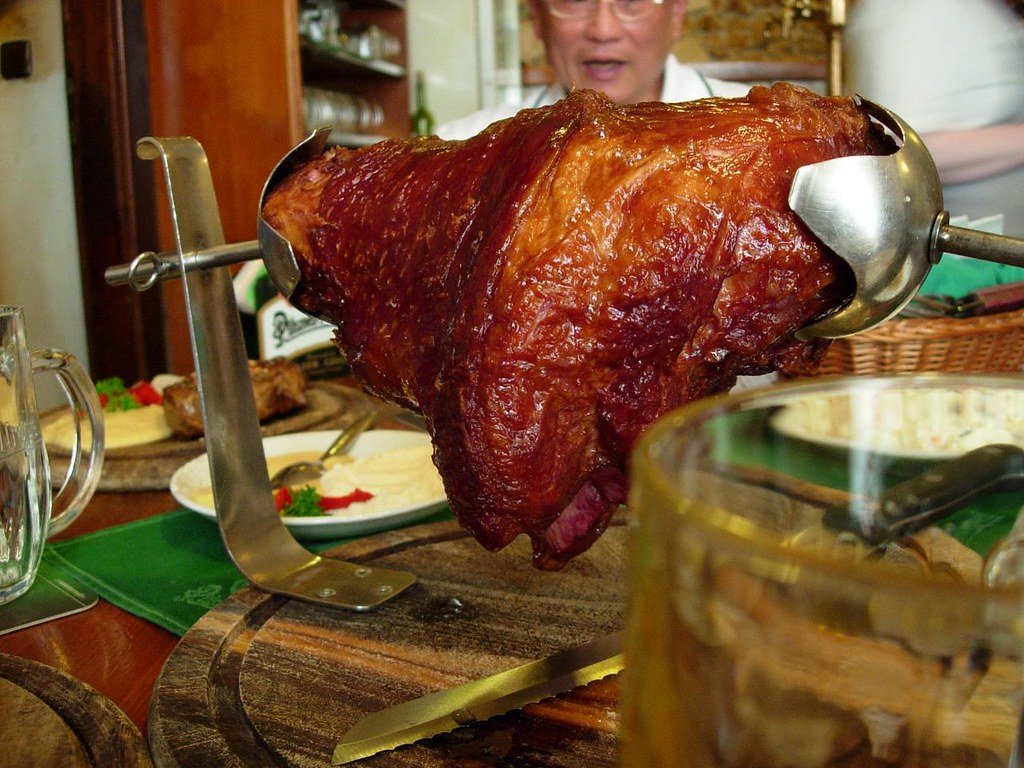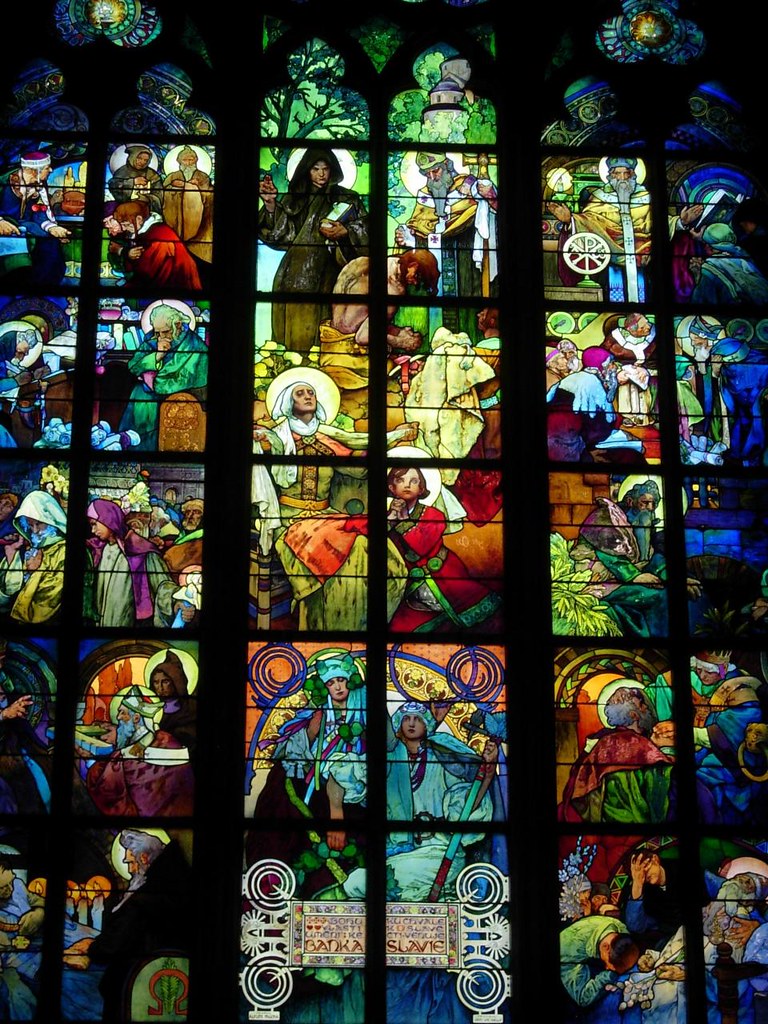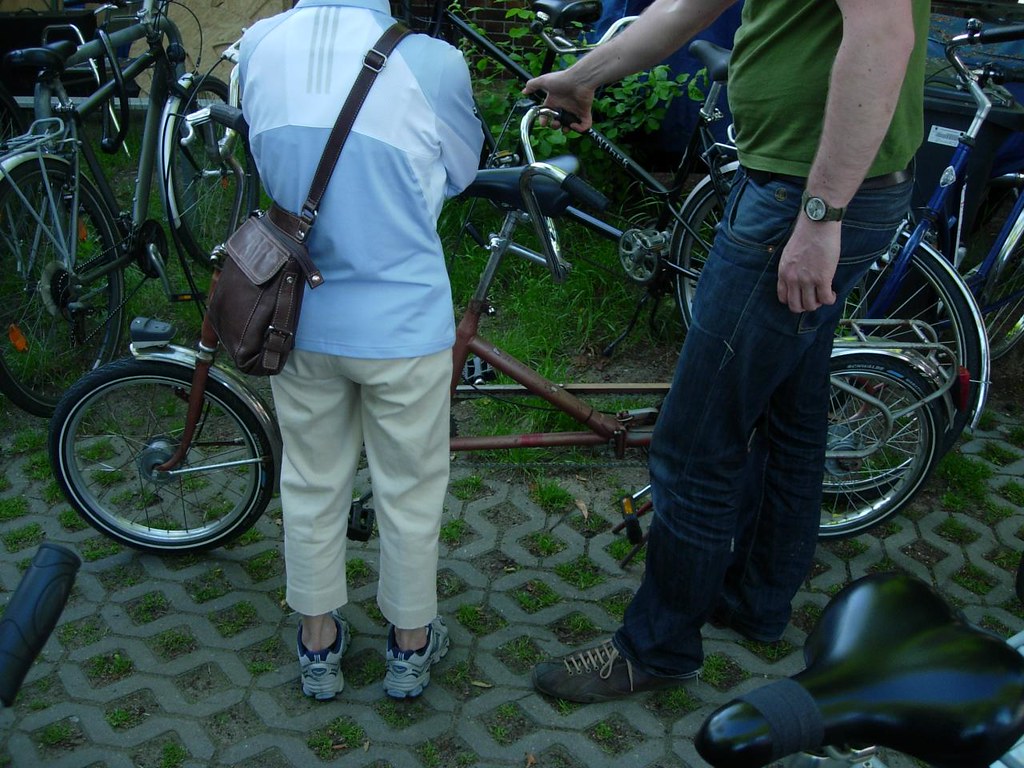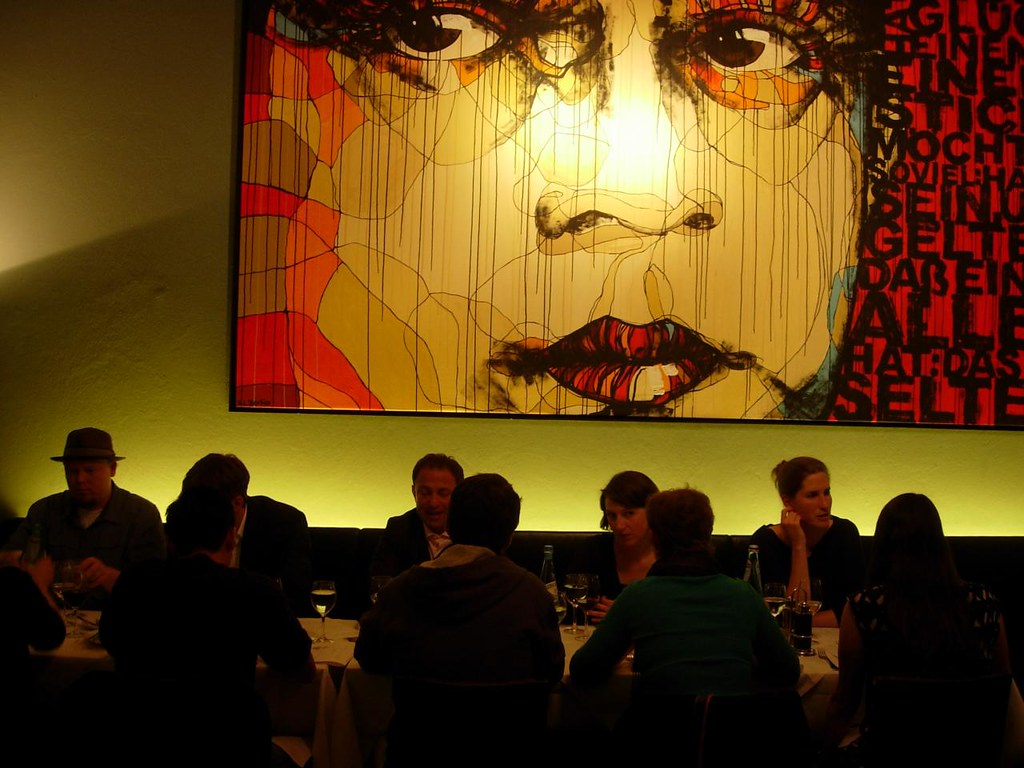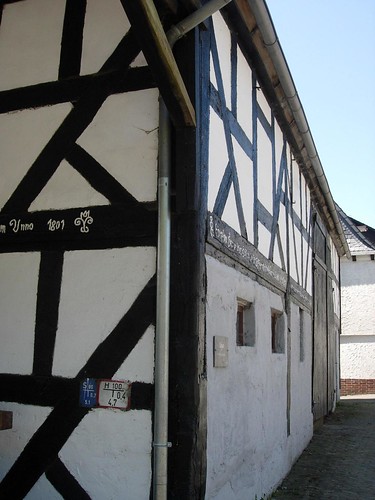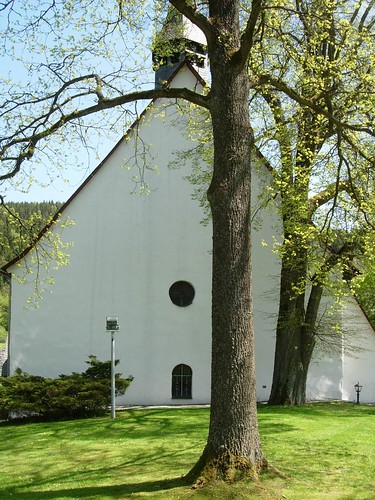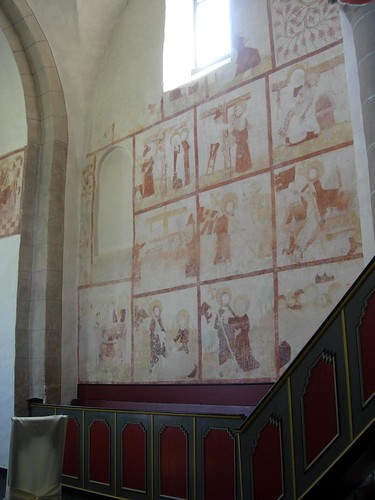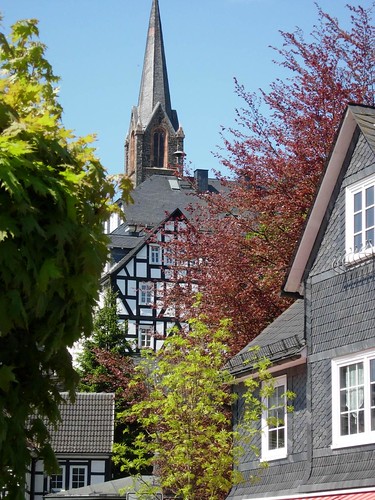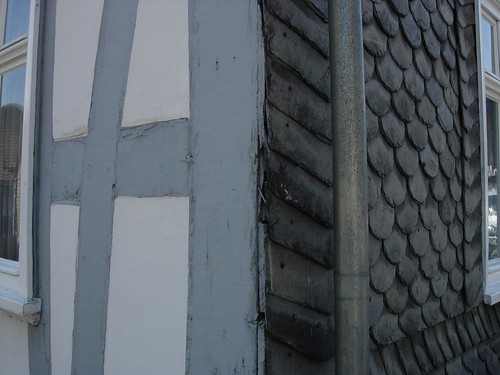June 9, 2010
On June 8 we said goodbye to E's parents and their friends. They headed back to the U.S. We hopped on a train to Vienna. The next morning we hopped on an airplane, and several hours later we landed in Istanbul.
June 6, 2010
I'm having trouble picking just one photo for this day, so I'm cheating.
After some further sightseeing in Berlin, E. and I, her parents, and their friends hopped on a train and headed toward Prague. June 6 was our first full day of sightseeing there. Here we are on the funicular on Petrin Hill.
We had lunch in a local pub, The Hippopotamus. If if you should ever need to entertain your in-laws in a far-away place, I recommend large pieces of roasted meat.
Everything about the cathedral is beautiful, but this window by Mucha is exquisite.
June 4, 2010
(Continued from May 28, 2010.)
After a quick visit to Bonn, we put my parents-in-law on a train to Mainz, where they joined a guided tour that looped through southern Germany, and then through eastern Germany, culminating in Berlin. Ah yes, Berlin, where E. and I were camped out.
On June 4 we took them and their biking in Potsdam, which was fairly hilarious given that two of the four couldn't ride bikes. We rented tandems for the occasion, including this heavy, old oddity.
After a quick visit to Bonn, we put my parents-in-law on a train to Mainz, where they joined a guided tour that looped through southern Germany, and then through eastern Germany, culminating in Berlin. Ah yes, Berlin, where E. and I were camped out.
On June 4 we took them and their biking in Potsdam, which was fairly hilarious given that two of the four couldn't ride bikes. We rented tandems for the occasion, including this heavy, old oddity.
May 28, 2010
It may help to tell the story if I jump back to the end of May. My parents-in-law and two of their friends flew into Frankfurt, and then took the train up to Bonn. On May 28 we took them on a quick tour of must-see destinations in the area: the Aachen and Cologne cathedrals, and Schloss Augustusburg (shown here).
June 3, 2010
We had a brief respite in Berlin post-fellowship, pre-in-laws. Taking advantage of this lull, E. and I made a point of it to see the recently opened Ritter Sport concept store near Friedrichstrasse. In case you have been deprived, Ritter Sport is by far the best brand of mass-market German chocolate. It is a brand we stand behind proudly. You might also stay it's a brand E. stands under, hoping nothing tips over.
June 1, 2010
After ten months in Germany for me (twelve for E.) it was finally time to say goodbye. The Fellows and their spouses gathered for a final shared meal at the Cafe im Literaturhaus in Berlin. It had been a cold and wet day. Our hosts had previously scheduled a farewell cruise, and over the course of the day, there was grumbling, and rumblings of bowing out. Who wanted to venture to the outskirts of Berlin to have dinner on a boat in the rain? We got lucky though: The boat company thought we were coming the next day, and the organizers had to come up with a plan B. Fortunately, plan B was cozy, artsy, and a short five-minute stroll from our hotel. We had had similar dinners many times before, and we were still in good spirits. It was hard to believe this was the end.
Resurfacing
If you follow this blog at all, you'll know that it's been a long while since there has been anything to follow at all. At last report it was May, E. and I were living in Bonn, and Lena was winning the Eurovision song contest. Since then--well, I don't want to give away the story, so I'll just say that a lot has happened.

With this in mind, I am setting myself a new task:to tell the story of the month of June with a photo a day. There may be a gap here or there, but I think I can pretty much do it. Here we go.

Live Blogging Eurovision 2010
29 May 2010
From the semi-final:
22:08 CET


20:20 CET
As regular readers of this blog know, I have fallen under the influence of the Eurovision Song Contest.
Lena Meyer-Landrut has been in the news a lot since she was selected to represent Germany in Eurovision 2010. She's rocketed to the top of the German pop charts, with three singles in the top five (nos. 1, 2, and 4). She has already become fodder for the German tabloid press, notably after people realized she had shown some skin acting in a television docu-drama, and because she hasn't seen her father in 16 years. Meanwhile, even coffee-purveyor Tchibo is selling Lena t-shirts in its stores. The headline in Spiegel Online is "The Cult of Lena-ism: Eurovision's Next Winner?"
Lena-mania aside, I haven't watched Eurovision since 1988. The funny thing is that what I remember about that show was that it introduced me to a great Irish rock band, The Hothouse Flowers. I later bought their single "Don't Go" on cassette. (On cassette! Can you believe that?) What a wee bit of googling just revealed to me is that 1988 is the year Celine Dion won the contest. Chances are that you haven't heard The Hothouse Flowers (and perhaps you should), whereas I bet that you have heard entirely enough of Celine Dion. Perhaps in 10 or 20 years tonight's contest will be comparably memorable and unmemorable.
20:55 CET
Whoa. I should have turned on the television sooner. There's a huge pre-Eurovision show on, and there are gigantic street parties across Germany. Everybody is screaming and waving little German flags.
20:58 CET
I wouldn't quite call it a prayer, but a preacher in civvies just gave a sort of inspirational op-ed about talent. Then the crowd screams 10 - 9 - 8 - 7 - 6 - 5... and the show begins.
21:20 CET
Daniel Diges (Spain) looks like a young Art Garfunkel. Not going to win. The story here is that somebody got up from the audience and started dancing during his act. Bouncers had to intervene.
21:22 CET
E. says Norway's Didrik Solli is "dreamy." Song is manipulative and uplifting. Song ends and E. says, "Did you see the ejaculation of fireworks?" Uh...
21:25 CET
Moldova's act is decent, but we're laughing out-loud at their costumes. The sax player is absolutely hilarious. ("He's humping his sax.") And what's the story on the guy with the electric, neon-rimmed violin? The German announcer narrating calls the lead singer the Moldovan Lady Gaga. That's saying something, but I'm not sure what.
From the semi-final:
21:37 CET
Belgium's Tom Dice is cute and charming. Looks like babyface Tobey McGuire, and sounds a bit like Paul Simon. Super talented.
Video of Tom in the semi-final:
21:39 CET
Regarding Serbia, um, is that a man or a woman who just walked out? Is this song polka or techno?
21:43 CET
Update. Because someone got on the stage while Spain was performing, they will get a second chance. Yeah, good luck with that. May actually be worse without a wiseacre messing things up.
21:45 CET
Dear Belarus, it would help if you could sing. And if you want to sing in English, perhaps you should also be able to pronounce English.
I think the German announcer says "kitsch als kitsch kann" at the end of the performance. Sounds like "catch as catch can," but I think he means "as kitschy as it gets."
21:57 CET
UK's mono-syllabic entrant, "Josh," is abominable. Worse than mushy peas. Makes my ears bleed. Rick Astley-esque, but wildly off-key.
22:00 CET
They just took a quick breather, but now it's on with the show. It's really nice to watch a show with no commercial breaks, and pretty much back-to-back performances. No unnecessary blah-blah.
22:07 CET
Turkey's entry is a really cool rock band called maNga. But what's with the grinder girl / robocop backup singer?
22:08 CET
Violins are big at this year's Eurovision. Is this the Alexander Rybak effect?
22:10 CET
Update. Announcer just said 7 of the acts this year have violins. Told ya so.
22:15 CET
Food for thought. The Superbowl attracts about 100 million viewers around the world. Because all those people are watching, there is huge commercial potential, and there are lots and lots of commercials. The Eurovision song contrast attracts about 125 million viewers. Maybe there is some other big televised event I've never heard of, but I'm guessing that makes Eurovision the biggest TV show on the planet. But there are no commercials.
Moral of the story: Europeans think differently.
22:20 CET
Regarding Alyosha from Ukraine:
I say: "She sounds like a Bond song."
E says: "She looks like a Bond girl."
22:23 CET
France has a chance. "Allez, allez, allez" is pretty catchy, I have to admit. Put your hands up. Clap your hands.
22:30 CET
Russia. E. says: "With all of these men singing, it's kind of like Fleet Foxes, but bad." I've said this before, but I'll have to say it again: don't sing English if no one will be able to tell you're singing English. And please, no high notes.
22:42 CET
Portugal's Filipa Azevedo can really sing.
22:35 CET
LENA! Germany's little black dress is back. Crowd eats it up.
22:34 CET
Armenia: The act is a little weird, kind of like a mini-musical theatre performance. But the song is actually pretty good. Helps that the singer looks like Angelina Jolie.
22:49 CET
Whoa, Israel, good looks don't make up for bad singing.
22:51 CET
Hey, Denmark, the 80s called. Said they want their sound back.
23:04 CET
Well, the singing is over, and the voting is taking place. So during this breather, I'd just like to tip my hat to one of the hosts who, at the end of the performances, stripped off his tux to reveal a wide-lapeled green disco shirt--thereby indicating that the work was over and the party was starting. I can't do his transformation justice, but it was unexpected, effective, and well-executed.
E and I have voted for Belgium and France. Yeah, we're hoping for Lena to pull it off, but we can't vote for the German candidate from Germany. So think of this as strategic voting, because the Eastern Europeans will vote as a block, so we need to counterbalance them by voting for Western European countries. Also, perhaps incidentally, we enjoyed the Belgian and French performers.
23:15 CET
Okay, I'm impressed. I am watching, live, thousands of people all across Europe dancing a Eurovision dance. Think: flash mob taking place simultaneously in Ljubljana, Düsseldorf, Hamburg, London, etc.
23:36 CET
E. just pointed out that all the countries of the former Yugoslavia voted for each other. They just fought each other in a war, but they'd rather vote for each other than let someone else get points.
Country by country, the points are being announced and tallied. Germany has a strong lead.....
23:30 CET
Portugal votes for Spain. Azerbaijan votes for Turkey. Greece votes for Albania and Cyprus. Iceland votes for Denmark. You see where I'm going with this? Now, the question is why. Are tastes regional? Do people just like their neighbors more than the people at the end of the street? Or do voting patterns merely reflect where immigrant communities live? (For example: In Germany you can't vote for Germany. But there are many Turkish immigrants living in Germany, and Turkey got a strong vote from Germany.)
30 May 2010
00:07 CET
No way Lena could possibly lose. She's currently leading with 234 points. Closest contender has 165. Meanwhile Belarus has 6 points. Told you that act was bad.
00:12 CET
LENA WINS WITH 246 POINTS. She's walking across the stage to heroic music.

Host: "Any words to describe this moment?"
Lena, out of it: "Hi."

Martin Dreisbach, b.May 23, 1717
If wives are honest and genealogies reliable, then my mother's mother's mother's father's father's mother's father was Martin Dreisbach, born May 23, 1717, in a house called "Leye" in a village called Raumland, in what was then the Earldom of Wittgenstein. Three days later he was baptised in St. Martin's Church. He immigrated to Pennsylvania sometime around the middle of the century, and died in Union County on February 18, 1799. (These details are gathered from The Dreisbach Book, a geneaology published in 1998 by the Dreisbach Family Association.)
I have often found that going in search of out-of-the-way places my ancestors once lived is an excellent way to spend the day. Yesterday's forecast was sunny and warm with a chance of afternoon ice cream--perfect weather for an excursion in search of Martin Dreisbach.
By German standards, Raumland is in the middle of nowhere. To get there I took the local S-Bahn from Bonn out to the end of the line, where I transfered to a regional train, which took me to Siegen, where I transferred to an even more regional train, which took me to Bad Berleburg. (That last train is just one or two cars long, and it has the single track entirely to itself. From Bad Berleburg there is nowhere to go except back.) Once I got to Bad Berleburg, I walked about 45 minutes to my destination. Total travel time: about 4 hours each way.
Raumland is very cute and very sleepy. The only local landmark is the church (currently Lutheran), which sits atop a crest. The surrounding homes are built in the local idiom, which is to say they have steep roofs and white walls, defined by sturdy dark timbers. The village is interspersed with small pastures of grass and dandelions, where horses, cows, and kitty cats pass their days.
It took me a bit of wandering, but soon found an old home--currently used as a barn--neatly labeled "Leye." (A note to any Dreisbach genealogists who might happen upon this blog entry: The inside cover of The Dreisbach Book has an old photo of Raumland, with an arrow labeling the "Birthplace of Martin Dreisbach." The arrow points to a building that is no longer there. The building I found labeled "Leye" is the house immediately behind the building to which the arrow points, and can be matched with the old photo by the pattern of the beams.) I spoke with several neighbors, none of whom had any special knowledge of the history of the house.
At the top of the hill, the preacher's daughter was practicing riding a unicycle, and unlocked the church for me. If you can read German, you can read more about its history here. The short version is that it is the oldest surviving church in Wittgenstein, built around 1240-1260. On one side of the choir, wall paintings depicting the way of the cross are visible. They date to the second half of the 15th century.
Having seen all there was to see, I strolled back to Bad Berlesburg. Nearly all the buildings there are covered in slate.
I don't know the whole architectural history of the area, but I'd be willing to guess that slate tiling is a more recent phenomenon, as you can infer from this photo of a house that has tile on the front, but visible timbering on the side.
And then I made my way home, again by way of Siegen, where I stopped to look around.
Having now been to the Siegtal (Sieg valley) I can see why travel books recommend it. It's not dramatic, but its rolling hills, green pastures, and black and white architecture are pleasant and picturesque.
I have often found that going in search of out-of-the-way places my ancestors once lived is an excellent way to spend the day. Yesterday's forecast was sunny and warm with a chance of afternoon ice cream--perfect weather for an excursion in search of Martin Dreisbach.
By German standards, Raumland is in the middle of nowhere. To get there I took the local S-Bahn from Bonn out to the end of the line, where I transfered to a regional train, which took me to Siegen, where I transferred to an even more regional train, which took me to Bad Berleburg. (That last train is just one or two cars long, and it has the single track entirely to itself. From Bad Berleburg there is nowhere to go except back.) Once I got to Bad Berleburg, I walked about 45 minutes to my destination. Total travel time: about 4 hours each way.
Raumland is very cute and very sleepy. The only local landmark is the church (currently Lutheran), which sits atop a crest. The surrounding homes are built in the local idiom, which is to say they have steep roofs and white walls, defined by sturdy dark timbers. The village is interspersed with small pastures of grass and dandelions, where horses, cows, and kitty cats pass their days.
It took me a bit of wandering, but soon found an old home--currently used as a barn--neatly labeled "Leye." (A note to any Dreisbach genealogists who might happen upon this blog entry: The inside cover of The Dreisbach Book has an old photo of Raumland, with an arrow labeling the "Birthplace of Martin Dreisbach." The arrow points to a building that is no longer there. The building I found labeled "Leye" is the house immediately behind the building to which the arrow points, and can be matched with the old photo by the pattern of the beams.) I spoke with several neighbors, none of whom had any special knowledge of the history of the house.
At the top of the hill, the preacher's daughter was practicing riding a unicycle, and unlocked the church for me. If you can read German, you can read more about its history here. The short version is that it is the oldest surviving church in Wittgenstein, built around 1240-1260. On one side of the choir, wall paintings depicting the way of the cross are visible. They date to the second half of the 15th century.
Having seen all there was to see, I strolled back to Bad Berlesburg. Nearly all the buildings there are covered in slate.
I don't know the whole architectural history of the area, but I'd be willing to guess that slate tiling is a more recent phenomenon, as you can infer from this photo of a house that has tile on the front, but visible timbering on the side.
And then I made my way home, again by way of Siegen, where I stopped to look around.
Having now been to the Siegtal (Sieg valley) I can see why travel books recommend it. It's not dramatic, but its rolling hills, green pastures, and black and white architecture are pleasant and picturesque.
One more from Paris
This is a nice photo of E. and me at a restaurant in Paris that I swiped off of Facebook.


And finally, Paris
Our trip to Belgium and France is already becoming sort of a fuzzy memory, so it's time to wrap this up.
The final stop of our tour was Paris. I have visited Paris many times, but I had not done so in nearly ten years. I enjoyed seeing the city again, but also didn't feel compelled to do and see everything. The weather was impeccable--perfect for meandering.
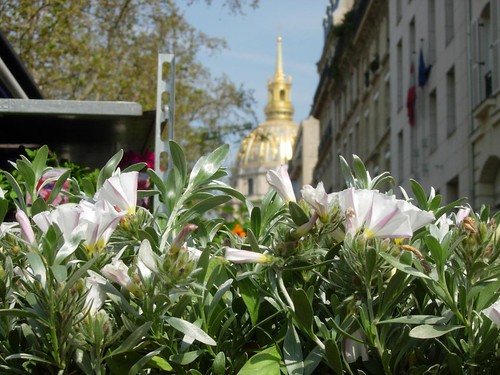
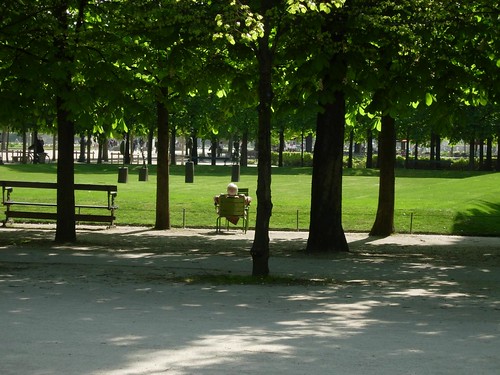
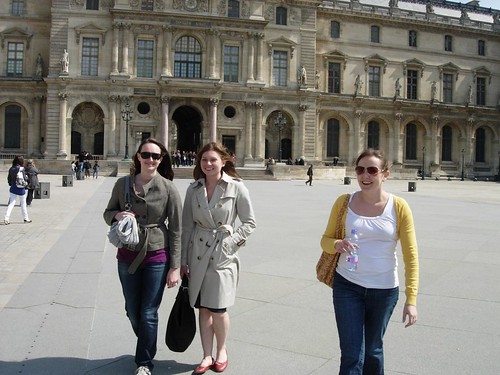


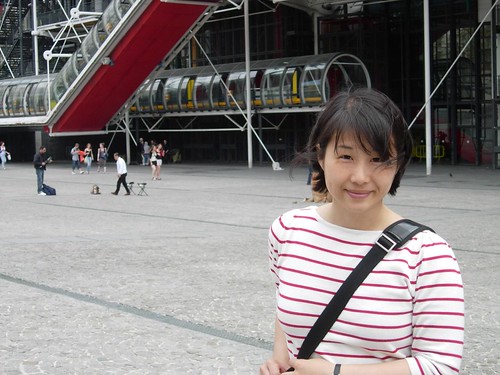
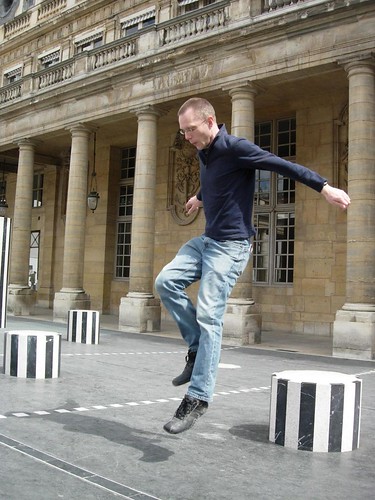
The final stop of our tour was Paris. I have visited Paris many times, but I had not done so in nearly ten years. I enjoyed seeing the city again, but also didn't feel compelled to do and see everything. The weather was impeccable--perfect for meandering.

Les Invalides

Jardins des Tuileries

Christina, Bonnie, and Lauren by the Louvre

Lauren and Christina at the Museum of Decorative Arts

Notre Dame

My lovely E.by the Pompidou

Palais Royal
A day in Alsatian wine country
Whoever you are, I have always depended on the kindness of strangers.
--Blanche DuBois, A Streetcar Named Desire
This is a story about happy accidents. During a biking tour of Strasbourg our Bosch group leader pointed out an art nouveau style building. Stasbourg, she noted doesn't have many fantastic examples of the style. For the good stuff you need to hop on a train and go to Nancy. Fellow Bosch spouse Christina is a great fan of all things art nouveau or Jugendstil, and she and I were quickly plotting an excursion to Nancy. (Nancy is on the UNESCO World Heritage Site list and in all seriousness, that list has never let me down.)
The next morning, we made it as far as the ticket line at the train station, when we concluded that we were never going to make it to the train. Down but not out, we gathered train schedules and stopped at a tourist information desk, where Christina made inquiries about venturing into Alsatian wine country. We regrouped. We recruited Bosch spouse Lauren to join us. And we hopped on a train headed for Obernai.
Outside the Obernai train station we stood in front of a map of the small town, getting our bearings. A bearded man in a suit approached us and asked us if he could be of assistance. No, no, we're just figuring out where things are, we replied. By the way, he says, I'm going to be helping a friend out at a private wine sale at his vineyard later in the day, and would you care to join me? We'll meet by the belfry at such-and-such an hour.
Christina, Lauren and I wandered Obernai, which would be sleepy on a busy day, and was extra sleepy on Monday, which the Germans would call Ruhetag, the day local businesses take a day off. We had some lunch, took photos of the white storks nesting on the roof of the granary (halle des bles), and met our new friend, Claude Mitschek, at the appointed hour by the belfry.

Before we leave, he says to us, I should like to show you some of the sights of the town. Obernai is a small place, so this amounts to walking us around the block. He showed us an unusual well, details on the renaissance town hall, the storks (local mascots to be sure), and this interesting spot on the wall of the belfry:
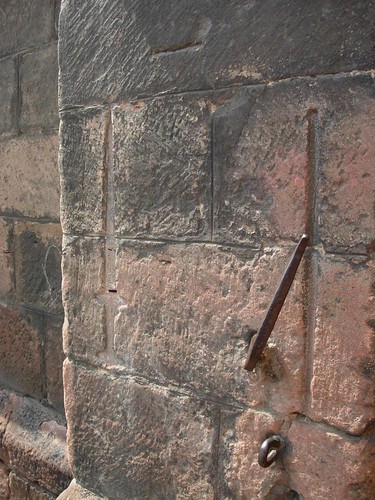
On the left, if you look closely, you'll see the outline of a short sword. To keep the peace, this was the maximum length of swords allowed at market. The metal hook was where unfaithful wives were tied to be taunted. And the line on the right was a standard measure (approximately, the distance from the elbow to the hand).
At this point fellow explorer Lauren bowed out of the afternoon excursion, but Christina and I hopped in our guide's car. Our destination was Barr, another little village up the road.

There, as promised, we found ourselves at a private wine tasting for commercial buyers.

Our host started us on some wines, but when some people who looked like more serious buyers approached, Christina and I made a point of it to stay out of the way. Not long after someone offered us a private tour of the cellars. And so after a quick snack of Flammkuchen...

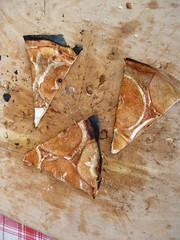
... we went off to learn everything about wine production: how much a bucket of grapes weighs, how to keep the grape varieties separate, how to stomp the grapes (with a giant inflatable balloon, in essence), why you have to keep air out of the casks, how nice it is to be able to hose out the inside of a metal cask, and on an on. Our extremely affable guide was, we think, shirking some other duty by spending time showing us around. He mostly spoke in small bursts, which I would do my best to translate for Christine, and I think we got the gist of almost everything.



Incidentally, at the end of our tour we walked through the distribution center, and I will surely never see so much wine again. Think of the scene at the end of Raiders of the Lost Ark--the warehouse full of crates--and you're not far off.
We bought some wine--it was the very least we could do--and made our way back to Strasbourg. We had a grand day out.
P.S. Needless to say, we recommend the fine wines by Ch. WANTZ.
 .
.
--Blanche DuBois, A Streetcar Named Desire
This is a story about happy accidents. During a biking tour of Strasbourg our Bosch group leader pointed out an art nouveau style building. Stasbourg, she noted doesn't have many fantastic examples of the style. For the good stuff you need to hop on a train and go to Nancy. Fellow Bosch spouse Christina is a great fan of all things art nouveau or Jugendstil, and she and I were quickly plotting an excursion to Nancy. (Nancy is on the UNESCO World Heritage Site list and in all seriousness, that list has never let me down.)
The next morning, we made it as far as the ticket line at the train station, when we concluded that we were never going to make it to the train. Down but not out, we gathered train schedules and stopped at a tourist information desk, where Christina made inquiries about venturing into Alsatian wine country. We regrouped. We recruited Bosch spouse Lauren to join us. And we hopped on a train headed for Obernai.
Outside the Obernai train station we stood in front of a map of the small town, getting our bearings. A bearded man in a suit approached us and asked us if he could be of assistance. No, no, we're just figuring out where things are, we replied. By the way, he says, I'm going to be helping a friend out at a private wine sale at his vineyard later in the day, and would you care to join me? We'll meet by the belfry at such-and-such an hour.
Christina, Lauren and I wandered Obernai, which would be sleepy on a busy day, and was extra sleepy on Monday, which the Germans would call Ruhetag, the day local businesses take a day off. We had some lunch, took photos of the white storks nesting on the roof of the granary (halle des bles), and met our new friend, Claude Mitschek, at the appointed hour by the belfry.

Before we leave, he says to us, I should like to show you some of the sights of the town. Obernai is a small place, so this amounts to walking us around the block. He showed us an unusual well, details on the renaissance town hall, the storks (local mascots to be sure), and this interesting spot on the wall of the belfry:

On the left, if you look closely, you'll see the outline of a short sword. To keep the peace, this was the maximum length of swords allowed at market. The metal hook was where unfaithful wives were tied to be taunted. And the line on the right was a standard measure (approximately, the distance from the elbow to the hand).
At this point fellow explorer Lauren bowed out of the afternoon excursion, but Christina and I hopped in our guide's car. Our destination was Barr, another little village up the road.

There, as promised, we found ourselves at a private wine tasting for commercial buyers.

Our host started us on some wines, but when some people who looked like more serious buyers approached, Christina and I made a point of it to stay out of the way. Not long after someone offered us a private tour of the cellars. And so after a quick snack of Flammkuchen...


... we went off to learn everything about wine production: how much a bucket of grapes weighs, how to keep the grape varieties separate, how to stomp the grapes (with a giant inflatable balloon, in essence), why you have to keep air out of the casks, how nice it is to be able to hose out the inside of a metal cask, and on an on. Our extremely affable guide was, we think, shirking some other duty by spending time showing us around. He mostly spoke in small bursts, which I would do my best to translate for Christine, and I think we got the gist of almost everything.



Incidentally, at the end of our tour we walked through the distribution center, and I will surely never see so much wine again. Think of the scene at the end of Raiders of the Lost Ark--the warehouse full of crates--and you're not far off.
We bought some wine--it was the very least we could do--and made our way back to Strasbourg. We had a grand day out.
P.S. Needless to say, we recommend the fine wines by Ch. WANTZ.
 .
.
Strasbourg
The next stop on our tour was Strasbourg, France, which is absolutely one of the most appealing cities I have ever visited. I genuinely had no idea, and in fact, Strasbourg had barely been part of my consciousness prior to this trip.
One strange twist was that a volcano had recently erupted in Iceland, disrupting air traffic across Europe. Someone from the Bosch foundation found herself stranded in Brussels. Our group leader therefore drove her to Germany so she could catch a train. An amusing consequence of this situation is that as the best French speaker in the group, I was designated to communicate with the drivers of the bus taking us from Brussels to Strasbourg.
The architectural highlight of Strasbourg is the cathedral, an exuberantly gothic concoction.
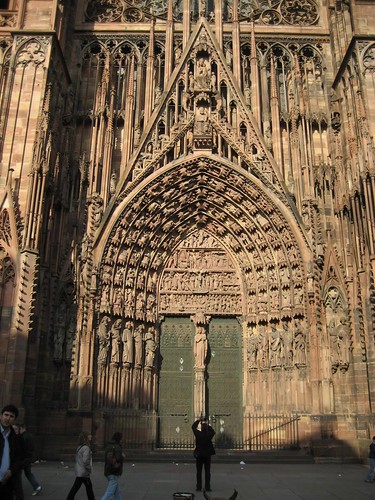
For aficionados, much of the stained glass is original.

The square in front of the cathedral attracts street performers. This burly man sang renaissance-era music in an amazing falsetto.
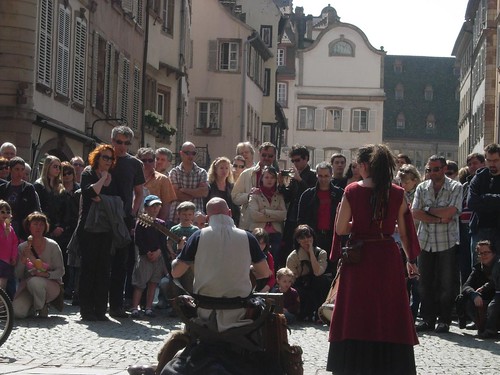
From on top of the cathedral, you get a great view of the old town.

One strange twist was that a volcano had recently erupted in Iceland, disrupting air traffic across Europe. Someone from the Bosch foundation found herself stranded in Brussels. Our group leader therefore drove her to Germany so she could catch a train. An amusing consequence of this situation is that as the best French speaker in the group, I was designated to communicate with the drivers of the bus taking us from Brussels to Strasbourg.
The architectural highlight of Strasbourg is the cathedral, an exuberantly gothic concoction.

For aficionados, much of the stained glass is original.

The square in front of the cathedral attracts street performers. This burly man sang renaissance-era music in an amazing falsetto.

From on top of the cathedral, you get a great view of the old town.

Bruges
The fate of a Bosch spouse is to pass the time while the fellows are tied up. Five days is kind of a long time to spend in Brussels as a tourist so on day three an expeditionary party consisting of four Bosch spouses, one Bosch significant other, and also a DAAD fellow and his spouse set off to visit Bruges.

Often described as touristy (true), Bruges is nevertheless one of the most appealing cities in Europe to visit. The canals remind you a bit of Venice or Amsterdam, though Bruges cleaner, quainter, and quieter than either of those cities.
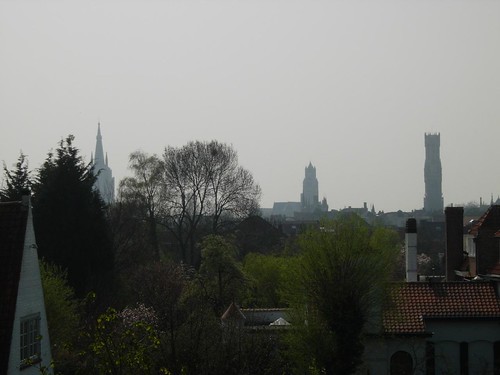



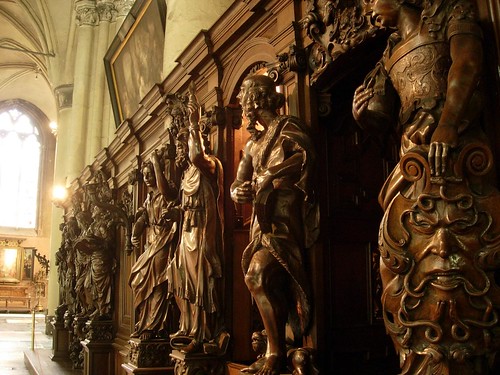



Often described as touristy (true), Bruges is nevertheless one of the most appealing cities in Europe to visit. The canals remind you a bit of Venice or Amsterdam, though Bruges cleaner, quainter, and quieter than either of those cities.







